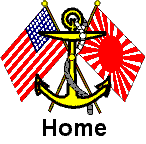|
By the time the Battle of Leyte Gulf ended with the utter destruction of the last of the Imperial Japanese Navy’s aircraft carriers in Ozawa’s Northern Force, Japan ceased to be a naval power. Although Kurita’s Center Force had escaped relatively intact with its battleships and most of its cruisers fully operational, the Imperial Japanese Navy never ventured out again in force to challenge the now omnipotently and overwhelmingly powerful American Navy.
Faced with the American inevitable invasion of their sacred homeland, the Japanese turned to a tactic that would inflict more casualties on the United States Navy than in any conflict up to that time -- the use of suicide aircraft that would crash into the American ships and try to stop the Americans in their tracks. The new word that entered the lexicon of military thinking was the word Kamikaze (Divine Wind) after the typhoon that saved Japan from a Mongol invasion in the 13th century. The Japanese figured that if they inflicted sufficiently serious damage on the American Navy, the Americans would stop the war and negotiate an end to it.
Some Japanese officers had been contemplating using suicidal tactics soon after the devastating defeat in the Battle of the Philippine Sea. After Taffy 3 had turned back the Center Force in the Battle off Samar, a few Japanese Kamikaze aircraft attacked the escort carriers of the American Seventh Fleet, inflicting some damage. The Japanese continued to launch Kamikaze attacks around Leyte in November 1944. In January 1945, they launched large scale Kamikaze attacks against the American fleet in Lingayen Gulf when the Americans landed on Luzon Island .
And the Japanese continued to use this devastating tactic throughout the rest of the Pacific war. During the invasion of Okinawa in April 1945, the Japanese raised the intensity of Kamikaze attacks to a fever pitch. In that battle in the waters around Okinawa, Kamikaze aircraft inflicted the most casualties on the American Navy than in any naval battle of World War II. But, the Americans persevered and took the embattled island. The Kamikazes had failed in their mission to stop the Americans.
The thunder in the Pacific finally ended after the Americans totally destroyed the Japanese cities of Hiroshima and Nagasaki with a new, devastatingly destructive weapon -- the atomic bomb. Japan finally surrendered in a ceremony on board the American battleship Missouri. The American Pacific Fleet was there along Admirals Nimitz, Halsey and Sprague and General MacArthur. At long last, the slaughter that had killed over 50 million human souls was over.
And the world would never be the same.
|


